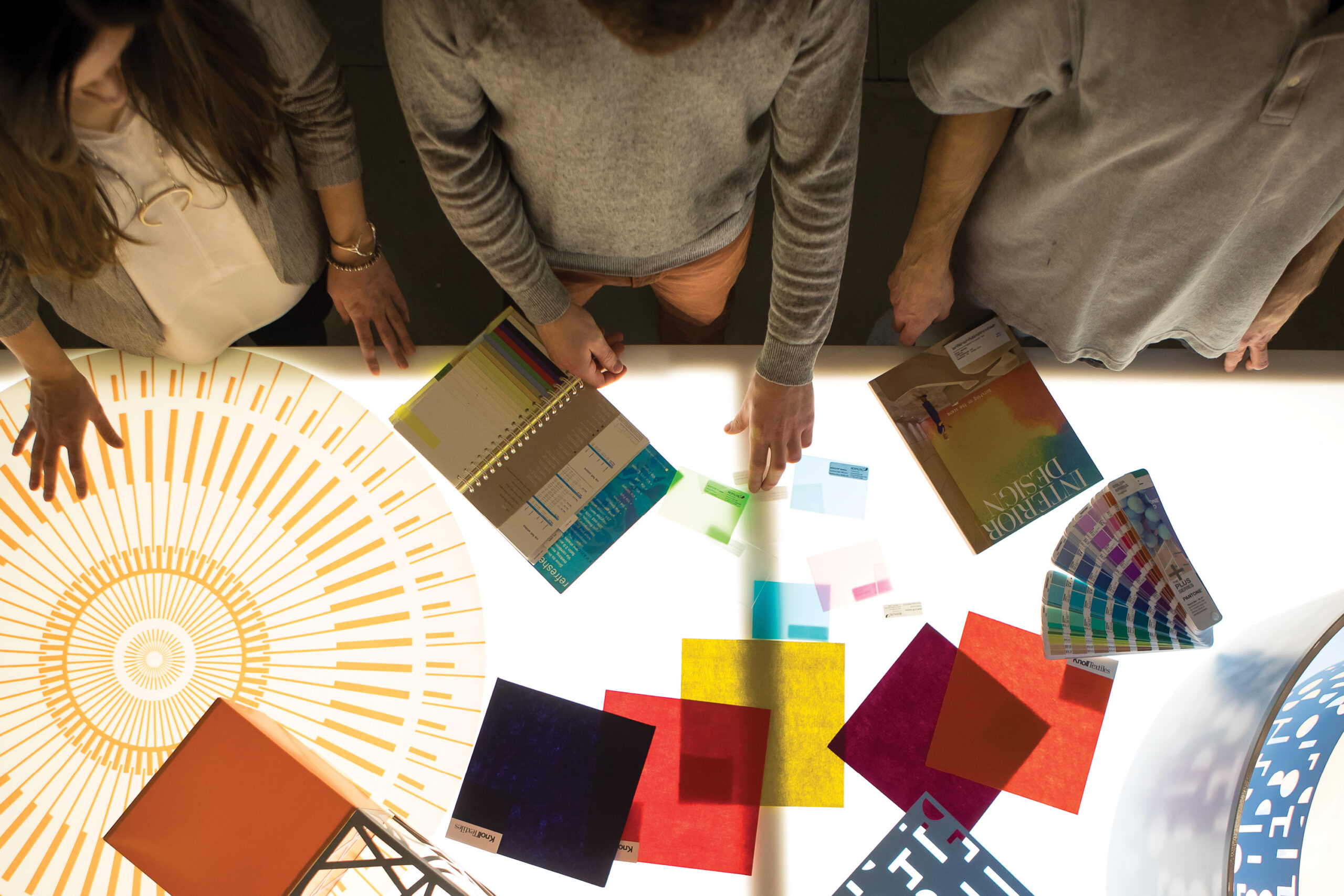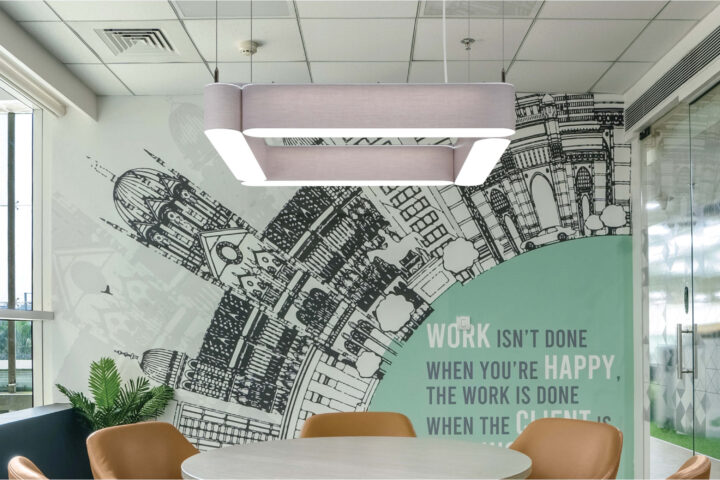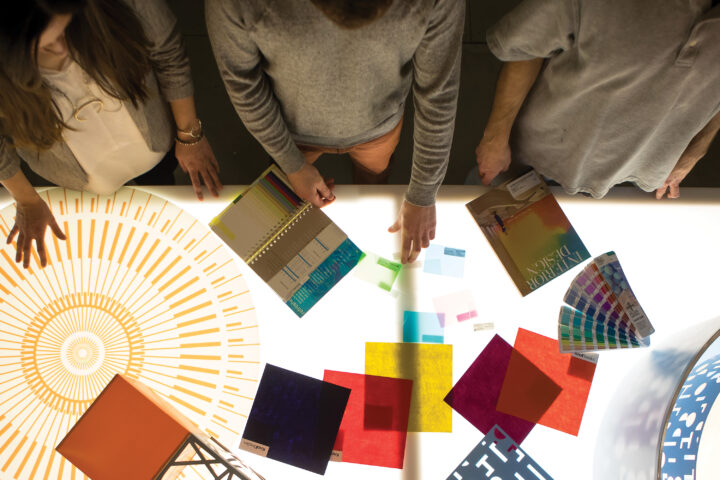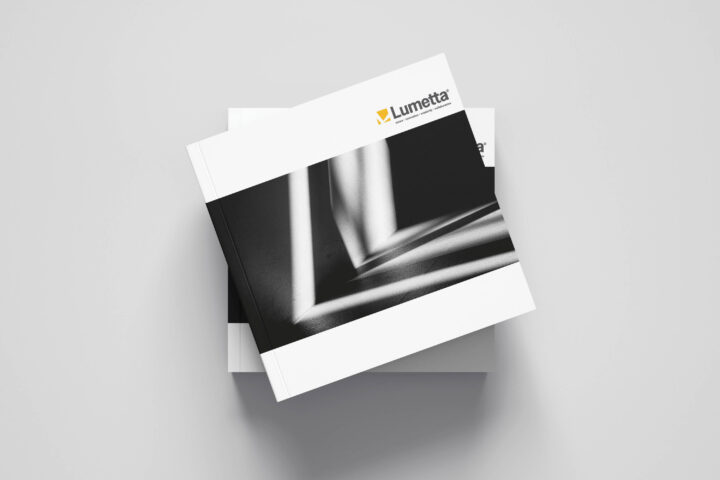Selecting the Right Lighting Materials for Your Next Design ProjectOctober 2024

When selecting the lighting materials for your next commercial design project, evaluating the various material options available can influence aesthetics, functionality, and the overall budget. Here’s an overview of common materials used in the design and manufacturing of lighting fixtures, and where they twinkle or shine.
Glass can provide a colorful, elegant look and has great light diffusion, but it is heavier and more fragile than other materials. This means the installation could require additional support, and specialized labor for installation and cleaning, which means this material should be considered for clients who have a healthier budget and are seeking specific experience within their space.
Hard Metals such as brushed nickel, chrome, and bronze can be durable and long lasting, and can add a modern or industrial design aesthetic depending on the chosen style and finishings. However, depending on the size of the project, Metal fixtures may require additional support to accommodate the weight, thus adding to the cost. Metal can be prone to corrosion in humid and harsher environments, so special treatments should be considered in those circumstances. Otherwise, it’s a long-lasting material that will have a long lifecycle.
Aluminum is another choice for frame construction and aesthetics. This metal, unlike its counterparts, is typically lighter in weight and cost compared to other metals. Aesthetically it can be powder coated to reflect the color and look of other metals and more. This is a premium choice for interior lighting due to it being a material that is easy to work with in construction, lightweight for installation and cost effective.
Acrylic or Polycarbonate Materials are both durable and lightweight and can be produced in a plethora of colors and patterns, making them versatile materials that can complement or seamlessly blend in any design space. Both of these materials can be designed for various lighting functionality and diffuse light well. They are often more durable and cost-effective than glass. Between durability and design this material choice can aesthetically and functionally accentuate a significant number of design landscapes.
Wood adds warmth and natural beauty to any space and is often eco-friendly if sustainably sourced. Its grain patterns, and variable stain colors can enhance a design aesthetic, however, wood is sensitive to humidity and will expand and contract, so unless properly cleaned and cared for, can weaken and become damaged over time.
Fabric softens light and reduces glare, creating a cozy atmosphere, and comes in a wide variety of colors, patterns and textiles. It’s often lightweight but requires regular cleaning or replacement because it absorbs dust and odors within its environment, which makes it unsuitable in many environments. It is not as durable and as long lasting as other materials.
Acoustic Felt: This material utilizes porous, sound-absorbing that effectively minimizes noise in various environments. Alongside its sound absorption capabilities, it is available in a variety of colors. While the selection of standard colors and patterns may be limited, custom colors and dyeing options can be manufactured to suit specific needs. Additionally, the material’s opacity restricts light transmission to upward and downward directions.
Ceramic is available in a number of glazes and finishes which creates a unique artisanal appearance, but the colors and styles are more limited than other materials. Ceramic is often durable and heat resistant, but it is often heavy and fragile, requiring a stronger support structure and careful installation. Therefore, this material should be considered only if your clients have a lofty budget.
Similar to wood, Rattan and Wicker have been used for centuries in lighting design. Depending on the weave, size, and colors it can range from whimsical to simple. This lighting material adds a natural, bohemian touch, is lightweight and easy to handle, and ecologically friendly. And while it does have some great benefits, it can be a challenge using either material to get the light to diffuse brightly or evenly, and its lifecycle is often shorter than most other materials because of quicker breakdown.
The choice of lighting materials significantly affects the overall look and function of a space.
Consider factors like durability, maintenance, aesthetics, and cost when making your selection to ensure it aligns with your design vision and practical needs.
Lumetta offers a variety of the materials previously mentioned such as Metals, Acrylic and Polycarbonate Materials. Our Lumenate® and TransLumenate® diffusers provide exceptional antimicrobial performance, adhering to the highest ASTM E2180 standards. Lumenate® effectively replicates the appearance of other materials, while providing durability and uniform light transmission.
Most of the materials we use are not only durable, lightweight, easy to clean and/or antimicrobial, they are recyclable.
All our products are available in countless combinations as standard as well as custom designs. We service the United States and Canada, and our products are manufactured by experienced craftsman in the Northeast United States.
Our Design and Engineering experts are available as a concierge service to provide you with further details and guidance on your specific projects.
To learn how Lumetta’s Design, Engineering, or Manufacturing experts can assist with your next project, contact us. We are here to guide you.
Have a question for our experts? We would love to hear from you—your question might be featured in our next column!







